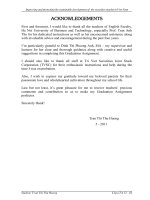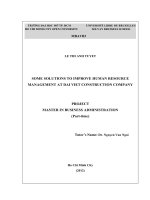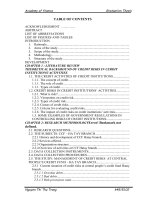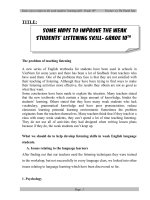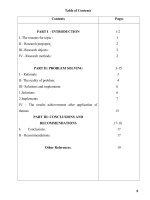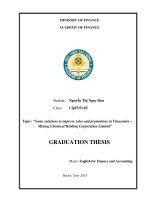These finding were the base for some solutions to improve the students’ translation quality
Bạn đang xem bản rút gọn của tài liệu. Xem và tải ngay bản đầy đủ của tài liệu tại đây (184.5 KB, 21 trang )
ACKNOWLEDGEMENTS
I would like to take this opportunity to express my sincere thanks to the
many people who have supported me in this assignment.
First of all, I would like to show my deepest gratitude to my supervisor,
Ms Nguyen Thi Kim Phuong, M.A, lecturer of the Faculty of Foreign
Language Studies, Tay Nguyen University for her sincerity, enthusiastic
guidance, and encouragement on every stage of this research.
Secondly, I want to give my sincere thanks to all teachers of the
English Department at Tay Nguyen University for their constructive opinions.
Finally, I would like to thank the students of English Bachelor class
K12 for their help in my survey of this paper.
ABSTRACT
1
Nowadays, because of the globalization and international cooperation,
language difference is an unavoidable problem. Translation, therefore, is more
and more popular and necessary in the process of conveying information. This
subject is now taught in many universities in Vietnam and Tay Nguyen
University is one of those. In Tay Nguyen University, the students must
practice to translate from English to Vietnamese and vice versa. With the
English majored students in Vietnam in general and the students in Tay
Nguyen University in particular, English-Vietnamese translation is considered
to be most difficult mode.
This study aims to discover the difficulties that the third year English
majored students at Tay Nguyen University face in their process of learning
English-Vietnamese translation and then giving some solutions to help them
to improve the quality of their translation.
The method used in the study is using the questionnaire and content
analysis. The questionnaires were delivered to 40 third year English majored
students.
The result of the study showed that most of the third English majors
had difficulty in translation from English into Vietnamese. It was hard for
them to avoid regrettable misunderstanding from a foreign language into their
mother tongue. These finding were the base for some solutions to improve the
students’ translation quality.
2
TABLE OF CONTENTS
3
LIST OF TABLES
Table 1: The perception about learning translation
Table 2: The students’ difficulties in grammar and lexical meaning
Table 3: The students’ difficulties in culture
Table 4: The students’ difficulties in synonym
Table 5: The students’ difficulties in connotation of meaning
Table 6: The students’ difficulties in method of thinking
Table 7: The ways to improve students’ translating
4
CHAPTER 1: INTRODUCTION
In this chapter, the background of the study, the objectives, the
significance, the scope of the study and the outline of the study will be
presented.
1.1. Statement of the problem
As globalization has increased, so no one can deny the importance of
language in the process of conveying information and the importance of
translation. Nowadays, more and more contracts, emails, news, etc. are in
English, so it is necessary to master translation to translate documents more
exactly in order to avoid regrettable misunderstanding. However, to master
translation is not easy, so not almost all learners can avoid mistakes.
Practically, the English learners at Tay Nguyen University have some
difficulties in learning English-Vietnamese translation, such as in cultural
differences, in language differences, in modes of thinking. Thus, this study
would like to find out the difficulties that the third year English majors at Tay
Nguyen University meet in learning English-Vietnamese translation and then
giving some solutions to help them to improve the quality of their translation.
1.2. Objectives of the study
This study aims:
• To find out what difficulties that the third year English majors
meet in learning translation.
• To help the third year English majors overcome the difficulties in
their translation by some suggested solutions.
1.3. Significance of the study
This study relies on the difficulties that the third year English majors
face when learning translation at Tay Nguyen University to point out some
solutions which are helpful for students. Hopefully, this study also help
teachers to recognize that difficulties and have more suitable teaching to help
their students learn translation better.
5
1.4. Outline of the study
The study is divided into four chapters:
Chapter I - Introduction, includes 4 sections: statement of the
problem, objectives of the study, significance of the study, outline of the
study.
Chapter II - Literature review, consists of 3 sections: the definitions
of translation, the functions of translation, the difficulties in English-
Vietnamese translation.
Chapter III - Contents and research methods, includes 4 sections:
subjects of the study, scope of the study, contents of the study, research
methods.
Chapter IV - Findings and discussion, presents the results of the study;
in this chapter, the researcher introduces the results collected by questionnaire
and analyzes them.
Chapter V - Conclusions and recommendations, presents some
recommendations and conclusions of the study.
6
CHAPTER 2: LITERATURE REVIEW
This chapter presents the basic concepts of translation, the functions of
translation and the rest of the chapter completely zoom in difficulties of
students in learning English-Vietnamese translation that have been identified
by some researchers.
2.1. The definitions of translation
The term translation can be understood in many ways. In broader term,
translation is an operation performed on languages, a process of substituting a
text in one language for a text in another. (Catford, 1965). And The National
Translation Bureau
TM
gave the definition of translation as: “ the process of
converting words from one language to another.”
A more detailed picture of translation can be seen clearly with the
definition given by Edmond Cary (1985): “Translation is a process which
attempts to establish equivalents between two texts expressed in two different
languages. These equivalents are, by definition, always dependent on the
nature of the two texts, on their objectives, on the relationship between the
two cultures involved and their moral, intellectual and emotional conditions.”
The other sees translation as an act of transferring messages from a
source language into a target language, be it oral or written, for the sake of
establishing equivalence to get the appropriate meaning (Yowell & Lataiwish,
2000).
Hatim and Munday (2004) define translation from two different
perspectives. First as a process, translation is an act of taking a text from one
language and transforming it into another. In this sense, Hatim and Munday
focus on the part of the translator. Second as a product, translation focuses on
the results achieved by translator, the concrete product of translation.
7
2.2. The functions of translation
The translating functions, as depicted by D.Cordero (1984) are as
follow:
“The need for translation is especially acute in our modern world. Not only do
nations depend on it to bridge what would otherwise be an impossible
communication gap, but it also affords access to a wealth of scientific and
technical information, as well as to the ideas that help shape our society.
Supersonic jets and communication have “shrunk” our world. Yet, ancient
language barrier are still in force and make translation more necessary now than
ever before. In fact, our age has been called the age of translation.”
2.3. The difficulties in English-Vietnamese translation
The difficulties in translation have been drawing the attention of many
researchers. Vu Ngoc Can (2007) says that “based on the origin, causes, we
divide difficulties into 3 categories: the difficulty comes from differences of
language, culture and modes of thinking".
2.3.1. The difficulties from difference of language
The study “Common mistakes in learning translation subject by the
second year English majors at Dong Thap University” (Duong Thi Thu Hang
and Nguyen Thi Cam Xuyen, 2010) found the followings:
“The translation, beside rich vocabulary, we should have a thorough
understanding of linguistic problems of both languages, understanding the
similarities and differences between the two languages not only in grammar but
also in term lexical meaning. If anything is missed, there is generally no
opportunity to become a successful translator.
Grammatical constructions vary between the source language and the receptor
language. The order of the words in the sentence may be completely reserved. The
following English simple sentence is given with a literal Vietnamese translation:
new house – ngôi nhà mới.
Lexical meaning is also the most seen difficulty and the most direct impact to the
process of translation. Each language has its own idiomatic way of expressing
meaning lexical items. Languages abound in idioms, secondary meanings,
metaphors and other figurative meanings. All languages have idioms – the string
of words whose meaning is different than the meaning conveyed by the individual
words.”
2.3.2. The difficulties from difference of culture
8
Culture in this discussion should be seen in a broad sense, as in
anthropological studies. Culture is not only understood as the advanced
intellectual development of mankind as reflected in the arts, but it refers to all
socially conditioned aspects of human life (cf. Snell-Hornby, 1988: Hymes,
1964). In practical wordings, Goodenough (1964) puts:
“As I see it, a society's culture consists of whatever it is one has to know or believe
in order to operate in a manner acceptable to its members, and do so in any role
that they accept for any one of themselves. Culture, being what people have to
learn as distinct from their biological heritage, must consist of the end product of
learning: knowledge, in a most general, if relative, sense of the term. By definition,
we should note that culture is not material phenomenon; it does not consist of
things, people, behavior, or emotions. It is rather an organization of these things.
It is the forms of things that people have in mind, their models of perceiving and
dealing with their circumstances. To one who knows their culture, these things and
events are also signs signifying the cultural forms or models of which they are
material representation."
Moreover, Nguyen Van Tuan (2006) found the followings:
“Culture could be understood as the total set of beliefs, attitude, customs,
behavior, social habits, etc. of the member of a particular society. In the broad
sense, it includes mode of production, production activities, community
organization, spiritual life, knowledge of nature and society, emotions, and moral
conceptions. Language is regarded as both a component of a culture and network
through which other elements of culture operate. Language therefore uses almost
all other cultural elements so as to perfect its universal and self-sufficient nature.
It could be said that we will not translate from this to that language perfectly
unless we know its relation to its culture.”
2.3.3. The difficulties from difference of mode of thinking
The study “The difficulties and some solutions to English Vietnamese
translation” (Nguyen Van Sinh, 2011) found the followings:
“Some translators depend largely on the meaning in dictionary picking out
the synonyms without paying much to the context. In fact, the pairs of synonyms
share at least one sense in common but do not share all their senses. To some
extent, they can hardly substitute for each other. The misuse of synonyms makes
the meaning of one of the following sentences unacceptable. “You have my
deep/ profound sympathy” (acceptable) “The river is deep” (acceptable)
“The river is very profound.” (unacceptable).
9
Another example shows that some translators do not realize the connotation
meaning, which leads to the distorting of the meaning of the sentence. Take
“famous” (nổi tiếng) as an example. While “famous” means “well-known/
celebrated”, and therefore contains some features of positive meaning,
“notorious” means “well-known” especially for unfavorable reason and
negative meaning.”
10
CHAPTER 3: CONTENTS AND RESEARCH METHOD
In this chapter, an empirical report is presented base on the findings from a
survey. The chapter starts with a brief description of the survey subjects, scope,
contents and method.
3.1. Subjects of the study
In this study, the subjects are difficulties when learning English-Vietnamese
translation and the way to learn this subject effectively.
3.2. Scope of the study
The study focuses on the difficulties in learning English-Vietnamese
translation of the third year English majors only.
3.3. Contents of the study
- Review literature related to the study
- Design data collection instrument such as questionnaires for students.
- Collect and analyze data
- Discuss some suggested solutions
3.4. Research methods
Questionnaire was chosen as a mean in this study. In order to find out the
answers to the research questions, and collect general data from students, a
questionnaire was delivered to 40 students of class English Bachelor 2012 during
break time and collected right after they finish it.
The questionnaire includes 8 questions:
Question 1 and 2 aim to find out the importance of translation subject.
Question 3 aims to investigate the difficulties from difference of language.
Question 4 is designed to find out the difficulties from difference of culture.
Question 5-7 are used to find out the difficulties from difference of mode of
thinking.
Question 8 is designed to find out the ways students improve their translation.
CHAPTER IV: FINDINGS AND DISCUSSTION
11
This chapter presents the results of the study and discussion of the
results. All the eight questions are analyzed and the responses of each
question will be discussed.
4.1. The importance of translation subject
To find out the awareness of students about the importance of
translation subject, two questions were designed.
Choices Number of students
(n=40)
Percentage (%)
A. Easy but not interesting 7 17.5
B. Difficult but interesting 30 75
C. Difficult and not interesting 2 5
D. Easy and interesting 1 2.5
Table 1: The perception about learning translation
The answers to the question 1 reveal that the number of the students
who like translation subject is obviously more than those who do not like it. It
is encouraging to see that most of them like learning translation subject
(95%). The results in the table also mean that the students interest in learning
translation. Their interest in the subject they learn will be a motive which
helps them try to learn it well. However, there are 5% of the students who
have not found their interest in learning translation.
From the response of question 2, the researcher can know the students’
feeling of learning translation subject. When the students were asked about
how they feel about learning translation, most of them (75%) answered that
translation is difficult but interesting. It can be inferred that although
translation is a difficult subject for them to master, they still feel interested in
learning it and thus they will try their best to learn and practice translation as
much as they can. There are only 2.5% of the students thought that translation
subject is not only easy but also interesting. The amount may be included
students who are much interested in translation subject and so that they feel
translation subject is an easy subject for them to learn. However, 5% of the
students chose the answer translation subject is both difficult and not
interesting. Moreover, 17.5 % of the students thought that translation is easy
12
but not interesting. From the result, it can be concluded that although there are
still small amount of the students (25%) who were not interested in learning
translation, most of the students expressed their positive attitude toward
translation subject. With those positive attitudes, the researcher hopes that
they can learn translation as well as they can and get much success.
4.2. The students’ difficulties in translating English – Vietnamese
To find out the students’ difficulties in translation, five questions in the
survey are intended to ask the students.
In question 3, the students were asked about the difficulties that they
met in translating English – Vietnamese texts. A vast number (77.5%) of the
students had troubles in both grammar and vocabulary. The number of
students who have problem in grammar points; specifically in finding suitable
grammar structures in the target language to transfer the ideas in the source
language was 15 %. Moreover, 7.5% of the students revealed that vocabulary
is their difficulty in translating English - Vietnamese texts. They usually
confuse in choosing appropriate vocabulary in the Vietnamese language. The
result prove that vocabulary or choosing words of Vietnamese language are
the big problem, and using grammar points is also challenge of the students in
the process of translating English - Vietnamese texts. The result was showed
in table 2:
Choices Number of students
(n=40)
Percentage (%)
A. Choosing appropriate
vocabulary in the Vietnamese
language.
3 7.5
B. Finding suitable grammar
structures in the target language to
transfer the ideas effectively.
6 15
C. Both A and B. 31 77.5
Table 2: The students’ difficulties in grammar and lexical meaning
13
Then, in question 4, the students were asked about the difficulties that
they met in learning translation. The number of students who have problem in
finding the ways to treat the cultural aspects implicit in a source text was
12.5%. . Moreover, 27.5% of the students revealed that finding the most
appropriate technique of successfully conveying the cultural aspects in the
target language is their difficulty in learning translation. The number of
students who realize that their difficulties in both were 60%. The result proves
that the difference of two cultures is the big problem. It requires some
effective and possible ways to help them overcome this problem. The result
was showed in table 3:
Choices Number of students
(n=40)
Percentage (%)
A. Finding the ways to treat the
cultural aspects implicit in a source
text.
5 12.5
B. Finding the most appropriate
technique of successfully
conveying the cultural aspects in
the target language.
11 27.5
C. Both A and B. 24 60
Table 3: The students’ difficulties in culture
Moreover, question 5 was designed to ask students whether they often
pick out the synonyms without paying much to context. A vast number of
students said “yes”. It made up 72.5% of the students. On the contrast, 27.5%
of the students did not think that they often pick out the synonyms without
paying much to context. The result was showed in following table:
Choices Number of students
(n=40)
Percentage (%)
A. Yes 29 72.5
B. No 11 27.5
Table 4: The students’ difficulties in synonym
In addition, question 6 was designed to ask students whether they often
got troubles in translation from English to Vietnamese because not realize the
14
connotation of meaning. Among them, 92.5% of students agreed that they got
troubles in translation from English to Vietnamese because not realize the
connotation of meaning. In the opposite direction, only 7.5% of the students
thought that they did not get any problem with the connotation of meaning.
The result was showed in following table:
Choices Number of students
(n=40)
Percentage (%)
A. Yes 37 92.5
B. No 3 7.5
Table 5: The students’ difficulties in connotation of meaning
Then, in question 7, the students were asked about the difficulties in
method of thinking when learning English-Vietnamese translation. As seen
from the table 6, 77.5% of the students agreed that the method of thinking of
each language cause many difficulties for them. On the contrary, only small
number (22.5%) of the students supposed that they did not get any problem
with the method of thinking when learning translation. The result was showed
in following table:
Choices Number of students
(n=40)
Percentage (%)
A. Yes 31 77.5
B. No 9 22.5
Table 6: The students’ difficulties in method of thinking
There are many difficulties that students face when learning translation.
So, it requires some effective and possible ways to help them overcome the
problems in order to make their English – Vietnamese translation smoother
and get more success.
4.3. How the students improve their translating
To know the ways that students do to improve their translation,
question 8 was designed to find it. The responses to question 8 show how the
students solve problems about translation skill. 12.5% of the students said that
they learnt vocabulary to improve their translating. 32.5% of the students who
have done grammar exercise from grammar books or from internet. 25% of
the students said that they usually updated their cultural and social
15
knowledge. 27.5% of the student chosen reading and practicing from
newspaper, magazines, article from English to Vietnamese. But only 2.5% of
the students have used all of these ways to improve their translating. The
result was showed in table 7:
Choices Number of students
(n=40)
Percentage (%)
A. Learning vocabulary 5 12.5
B. Doing grammar exercises from
grammar books or from internet
13 32.5
C. Updating cultural and social
knowledge.
10 25
D. Reading and practicing
translating from newspaper,
magazines, article from English to
Vietnamese
11 27.5
E. All the above 1 2.5
Table 7: The ways to improve students’ translating
In conclusion, chapter 4 has presented and analyzed the results gathered
from the questionnaire. It can be seen that the students interest in learning
translation but they still met with many difficulties in grammar, lexical
meaning. Besides, the students often met some mistake in culture and modes
of thinking. Through the students’ difficulties in learning translation, the last
question was designed to find out the ways that students do to improve their
translation, consist of: learning vocabulary, doing grammar exercises from
grammar books or from internet, updating cultural and social knowledge,
reading and practicing translating from newspaper, magazines, article from
English to Vietnamese.
16
CHAPTER 5: CONCLUSIONS AND RECOMMENDATIONS
5.1. Conclusions
The study aims to investigate some difficulties that Tay Nguyen
University’s English majors meet in their process of learning English –
Vietnamese translation. Through the study, the researcher wishes to give some
suggestions to develop the translation quality of third year English majors at
Tay Nguyen University.
In the study, the questionnaire was used as the data collection
instrument. From the data collected, the results were analyzed and discussed
carefully. The researcher analyzed some factors that affected the students’
translation process.
The results of the study showed that most of the English majored
students liked learning translation subject but they found that it was hard for
them to learn. They still met with many difficulties in grammar, lexical
meaning. Besides, the students often met some mistake in culture and modes
of thinking, etc. Especially, through five questions about the difficulties of
student when learning English-Vietnamese translation, the results showed that
students couldn’t realize the connotation of meaning, so it was the biggest
problem in translation. And they also found that choosing words of
Vietnamese language and using grammar points were challenge in the process
of translating English - Vietnamese texts. Moreover, the method of thinking
of each language also cause many difficulties for them.
From the results, some recommendations were made in order to help
the students improve their translation quality. It is expected that this study will
be helpful for English majored students and teachers in Tay Nguyen
University in the process of learning English-Vietnamese translation.
5.2. Recommendations
Understanding the difficulties of students when learning English-
Vietnamese translation, some recommendations were stated to help them
17
overcome the problems in order to make their English–Vietnamese translation
subject easier and get more success.
Vu Ngoc Can (2006) has suggested three solutions to improve students’
translation skill:
“Firstly, translator may be applied the similarities and differences - one of
the purposes of the works a couple to bilingual or multi-language
translation of languages into other languages now.
Secondly, a heavy duty is to always improve both their native language and
foreign language. Good translator must be fluent in several foreign
languages, especially, in the mother tongue and the language translation.
Thirdly, translator must always cultivate more comprehensive and
extensive knowledge. Schools are offered so much but not enough;
translator must learn more about culture and civilization of his country and
the country which they learn about.”
Moreover, to improve English grammar about verb tenses, they should
find out some reference books which contain not only uses and forms of all
tenses in English but also many exercises of each tense for the learners to
practice. The students also must enlarge vocabulary by studying whenever and
wherever they can. In addition, to avoid cultural substitutions over issues of
culture, translators should keep in mind that sometimes an effort to translate
correctly is not as a suitable substitution. Finally, they must fill up their lack
of knowledge. To do so, they should update their cultural and special
knowledge frequently.
18
REFERENCES
Catford (1965), A linguistic theory of translation, London: Oxford
University Press
Hatim and Munday (2004), Translation: An Advanced Resource Book,
Longman: Longman Group Limited
Yowell & Lataiwish (2000), Principles of Translation,Libia: Dar Annahda
Alarabiya
Edmond Cary (1985), translation and language
Hymes. Dell. (ed). Language in Culture and Society. A Reader in Linguistics
and Anthropology. New York: Harper & Row.
Snell-Hornby, Marry. 1988. Translation Studies: An Integrated Approach.
Amsterdam: John Benjamins B.V.
Ward Goodenough (1981), Culture, Language, and Society.
Vũ Ngọc Cẩn (2007), Các khó khăn trong dịch và phương pháp khắc phục,
Jorrnal of Language and life
Nguyễn Văn Tuấn (2006), Translation 1&2 , Hue University
Duong Thi Thu Hang and Nguyen Thi Cam Xuyen, (2010), Common
mistakes in learning translation subject by the second year English majors at
Dong Thap University, Dong Thap University
Nguyen Van Sinh (2011), The difficulties and some solutions to English
Vietnamese translation, Son La University
19
APPENDIX
QUESTIONNAIRE
Dear Sir/Madam,
I am a student of Tay Nguyen University, Department of Foreign studies, and
presently doing an investigation into difficulties in learning translation and
some suggested solutions for the third year English majors at Tay Nguyen
University. Request you to kindly fill the questionnaire below and assure you
that the data generated shall be kept confidential.
Question 1: People say that learning translation subject is important. Do
you agree?
A. Yes
B. No
Question 2: What do you think about learning translation?
A. Easy but not interesting
B. Difficult but interesting
C. Difficult and not interesting
D. Easy and interesting
Question 3: What is your difficulty in translating English-into-
Vietnamese texts?
A. Choosing appropriate vocabulary in the Vietnamese language.
B. Finding suitable grammar structures in the target language to transfer the
ideas effectively.
C. Both A and B.
Question 4: Which of these following difficulties do you often meet in
learning translation?
A. Finding the ways to treat the cultural aspects implicit in a source text.
B. Finding the most appropriate technique of successfully conveying the
cultural aspects in the target language.
C. Both A and B.
20
Question 5: In translation, do you often pick out the synonyms without
paying much to context?
A. Yes.
B. No.
Question 6: Do you often get troubles in translation from English to
Vietnamese because not realize the connotation of meaning?
A. Yes.
B. No.
Question 7: Does the method of thinking of each languages cause many
difficulties for you?
A. Yes.
B. No.
Question 8: What do you do to improve your translation skill?
A. Learning vocabulary
B. Doing grammar exercises from grammar books or from internet
C. Updating cultural and social knowledge.
D. Reading and practicing translating from newspaper, magazines, article
from English to Vietnamese
E. All the above
21

